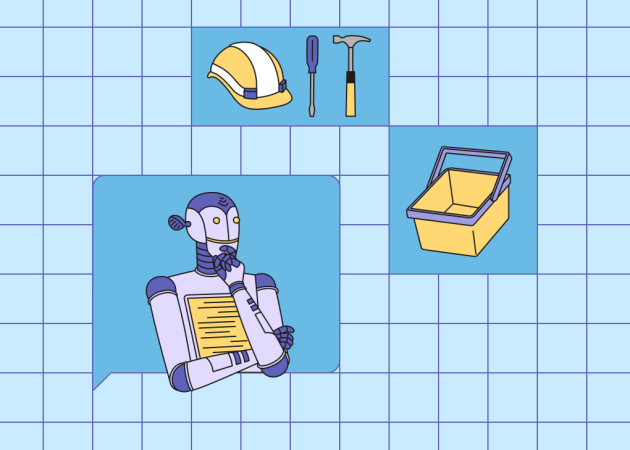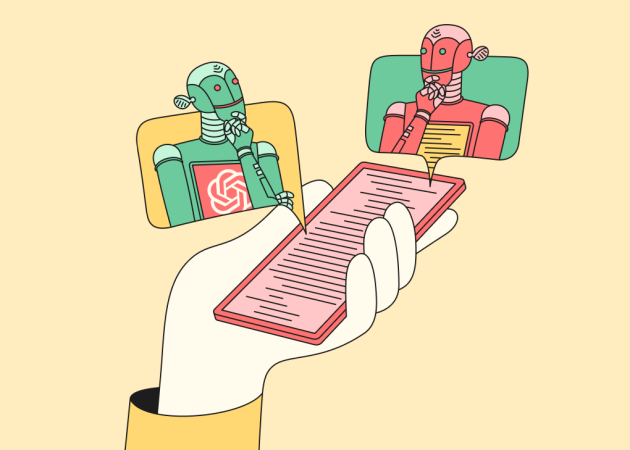
Build vs. Buy: When to Go Custom with Your AI Chatbot
Contents
Contents
Agentic AI is gaining momentum, offering the potential for sharper automation, faster decisions, and smoother operations. As more vendors release their own “agentic” tools, one question stands out: Should your organization build AI agents in-house or adopt a ready-made solution?
When applied effectively, AI chatbots, from standard conversational interfaces to high-end agentic models, can transform customer service, simplify operations, and make strategic goals more achievable. The challenge is that the market is now filled with products labeled as “agents” that are, in reality, just enhanced chatbots or RPA scripts with limited autonomy.
Powered by large language models (LLMs), true agentic AI systems go beyond pre-programmed responses and can understand objectives, plan multistep actions, make decisions, and execute them independently. They act more like proactive, goal-oriented virtual assistants than simple tools.
Within this category, agentic AI chatbots represent a more advanced end of the spectrum. Whether you choose to build or buy them will determine how fully you can leverage their capabilities and how far you can take task automation, customer support automation, and complex user journey automation. Let’s explore how to make the right decision for your organization.
Understanding Advanced AI Chatbots
An agentic AI chatbot is part of the broader AI chatbot scale that combines conversational intelligence with autonomous decision-making. At its simplest, it’s a system that can work with a degree of independence. It can set a plan, adapt as conditions change, and continue without step-by-step human guidance. LLM-powered chatbot technology makes that possible by breaking big objectives into smaller tasks, weighing options, and making decisions on the fly.
These agents are built for seamless integration. They can plug into APIs, databases, business apps, and other virtual assistant tools to pull in the data they need and act across different systems. In a multi-agent setup, they can even share information and coordinate to complete more complex workflows without human intervention.
One of the most significant upgrades from older automation is memory and context. A proper agent remembers previous interactions, understands the end goal, and adjusts its actions to stay on track. That’s how it can keep a real-time chatbot interaction consistent over days or troubleshoot an IT issue without starting from scratch every time.
Another advantage is tool use. An agent might check a database, update a dashboard, and trigger a follow-up in your project system without pauses, manual hand-offs, or delays in AI tool orchestration.
Practical examples include:
- A procurement agent that compares supplier quotes and updates purchase orders automatically.
- An onboarding agent that walks clients through forms while syncing their details across departments.
- An IT agent who diagnoses and resolves common system issues before they hit the helpdesk queue.
Build vs. Buy AI Chatbot: Three Ways to Get a Desired Solution
Once you have determined the value that an AI chatbot can bring to your business, the next question is how to get one that’s worth the investment. Most companies end up going down one of three roads, each with its trade-offs in speed, flexibility, cost, and control.
Build from Scratch (Custom AI Chatbot)
This approach means designing and building the chatbot in-house or with a trusted chatbot development partner, using frameworks like Rasa, LangChain, or a fully custom LLM setup.
Pros:
- You own the data, the code, and the IP
- Fully tailored to your workflows
- Seamless integration with your existing internal systems, including legacy and proprietary ones
Cons:
- Requires serious AI/ML and engineering team expertise
- It’s the slowest route to launch
- Needs higher upfront investment and ongoing chatbot maintenance considerations
Example: A bank building its legal document review chatbot, so no sensitive data ever leaves its servers. Similar to the approach JPMorgan took with its generative AI assistant: as of 2025, their LLM Suite has ~200,000 internal users.

Use a Configurable AI Chatbot Platform
Here, you start with a ready-made foundation, a low-code, no-code, or SDK-based AI chatbot platform like Microsoft Bot Framework, Google Dialogflow CX, or Cognigy, adapting it to your needs. These low-code AI solutions and no-code chatbot builders can help you reach a working chatbot MVP faster while allowing moderate customization.
Pros:
- Faster to get a functional chatbot live
- Vendor manages hosting, updates, and chatbot security patches
- You can adapt features, flows, and branding without rebuilding the core system.
Cons:
- Limited customization compared to a custom solution
- Partial vendor lock-in
- Subscription and add-on costs can increase over time
Example: A retail chain launching a chatbot MVP for customer service, later adding real-time stock checks and loyalty program integrations once the initial product proves its value.
Deploy a Preconfigured Chatbot Solution
This is a plug-and-play approach: you choose a chatbot solution prebuilt for a specific function, such as appointment booking, FAQs, or lead qualification.
Pros:
- Fastest to launch — sometimes within days
- No need for an in-house tech team
- Vendor handles hosting, updates, and compliance (if included in the service plan)
Cons:
- You get a boxed solution with a fixed feature set
- High risk of vendor lock-in
- You might need to bend your processes to fit the tool, rather than adapting the tool to your processes
Example: A healthcare provider deploys a HIPAA-eligible chatbot with a signed BAA and proper configuration for scheduling and refills.
Build vs. Buy AI Chatbot: Key Decision Factors
| Criteria | Build from Scratch | Configurable Platform | Preconfigured Solution |
| Customization | Unlimited | Moderate–High | Low |
| Speed to Market | Slowest | Medium | Fastest |
| Upfront Cost | High | Medium | Low |
| Ongoing Cost | Variable (your team) | Subscription + add-ons | Subscription |
| Data/IP Ownership | Full | Partial | Minimal |
| Vendor Lock-In Risk | Low | Medium | High |
| Required Team Expertise | High | Medium | Low |
| Chatbot Integration Depth | Complete control | Good, platform-dependent | Limited |
| Scalability | On your terms | Within platform limits | Limited by vendor |
| Best For | Complex, regulated, high-control needs | Balanced needs with room to customize | Standard, low-complexity jobs |
No single route is universally “the best.” If speed is the main goal, preconfigured or platform-based options will get you there faster. If the priority is greater control, stronger data security, or creating a high-value system, the custom route can justify the extra time and cost. Deep customization is essential when businesses need the chatbot to mirror their brand identity, support complex integrations, and deliver experiences tailored to specific customer needs.
Some teams opt for a hybrid approach, starting with a platform or prebuilt tool to prove the concept, then investing in a custom build once they know exactly what works. Next, we’ll look at when it makes sense to go all-in on custom and when buying is the smarter play.
When to Build a Custom AI Chatbot
Building your own AI chatbot isn’t always the fastest or budget-friendly choice. But for certain scenarios, it’s the only approach that delivers the required flexibility and control over your system. If you need a solution tailored to your business, and scalable automation or agentic AI capabilities are part of your strategic plan, custom is where you get that balance.
Consider a custom build when:
- You have highly specific requirements. Off-the-shelf chatbots can handle many common use cases, but complex workflows, unusual data structures, or non-standard customer journeys quickly lead you beyond the limits of a plug-and-play tool.
- Integrations with internal systems are critical to your use case. Maybe you’ve got proprietary software, a decades-old database, or sensitive processes that can’t leave your network. In a custom-build scenario, you decide exactly how your chatbot connects to those systems.
- You need control over the roadmap. When you own the technology, you decide what features get developed, when to update, and how the chatbot evolves, not waiting for a vendor’s roadmap to align with your priorities.
- More than one team will use it. With a custom product, you can design modular parts, so the same core bot can work for multiple departments. Support today, HR tomorrow, IT helpdesk next quarter.
- Avoiding vendor lock-in is a priority. If flexibility matters, or you’ve been burned by lock-in before, building from scratch keeps you free to adapt without rewriting your entire strategy.
- You have (or plan to get) the skills. A custom chatbot needs solid AI/ML and development expertise. If you already have that capability in-house or acquired it through a trusted partner, you’re equipped to create a solution that lasts.
Example: A logistics company operating across multiple countries needs a chatbot to coordinate shipments, process customs forms, integrate with several internal systems, and maintain compliance in different jurisdictions. No off-the-shelf product can meet all of these requirements out of the box — they need to build a custom platform.

When to Buy (or Start with a Pre-Built Tool)
Buying a pre-built or vendor-provided chatbot platform gets results to market faster with less strain on internal teams. When speed, predictable costs, and rapid chatbot deployment outweigh the need for full customization, it’s the most effective route.
Consider buying when:
- You need to get to market faster. For a proof of concept, closing a service gap, or handling a seasonal demand spike, a ready-made chatbot can be launched in days or weeks rather than months.
- The use case is well-defined and common. FAQ bots, helpdesk assistants, and booking tools are covered by existing solutions that work out of the box.
- Internal resources are limited. Without AI/ML engineers, UX designers, or integration specialists (and no short-term plan to hire them), a vendor-led deployment removes delivery bottlenecks.
- Vendor lock-in is an acceptable trade-off. When current flexibility needs are met and speed is the priority, dependency is a fair price to pay.
- Predictable operating costs are a priority. Subscription-based pricing makes budgeting easier compared to a large upfront build investment.
Example: A mid-sized e-commerce company deploys a preconfigured AI chatbot ahead of peak shopping season to answer product questions, process simple returns, and reduce call center load. After the season, performance data guides whether to invest in a custom platform.
Pitfalls to Avoid When Deciding to Build or Buy an AI Chatbot
Even with a clear understanding of the AI chatbot they want, from a standard conversational model to an advanced agentic AI solution, businesses can lose time and budget by overlooking common risks:
Challenge #1. Taking vendor claims at face value. Many marketed “AI agents” could in reality be enhanced chatbots with limited adaptability that fail in real-world workflows.
How to avoid it: Request a proof-of-concept or pilot build with your own data and workflows before committing. A skilled development partner can benchmark different solutions against your operational needs to validate real-world performance.
Challenge #2. Underestimating integration complexity. Connecting to CRMs, ERPs, or proprietary systems often takes more effort than marketing suggests.
How to avoid it: Include a detailed integration scope early in the project plan, mapping out data flows, API requirements, and security considerations. Engage technical stakeholders from both sides to validate compatibility and identify potential blockers before development begins.
Challenge #3. Rushing into vendor contracts. Without confirming flexibility and roadmap alignment, a short-term win can become a long-term limitation.
How to avoid it: Assess how well the vendor’s roadmap matches your growth plans and technical requirements. Negotiate for exit clauses or data portability options so you can pivot if the platform no longer meets your needs.
Challenge #4. Designing for one department only. Lacking reusability forces costly rebuilds when other teams need similar capabilities.
How to avoid it: Build a modular architecture and shared knowledge base from the start, so new departments can adopt and adapt the chatbot without duplicating work.
Challenge #5. Skipping post-launch planning. AI systems require updates, tuning, and maintenance to remain effective.
How to avoid it: Allocate budget and resources for continuous monitoring, model retraining, and feature updates. Treat the chatbot as a long-term product, not a one-off project.
Challenge #6. Scaling too soon. Attempting an enterprise-wide rollout before validating value in a smaller scope risks poor adoption.
How to avoid it: Start with a limited rollout in one team or use case, measure performance, and refine the system before expanding to other areas of the business.
Conclusion: How a Trusted Development Partner Can Help in AI Chatbot Development
There is no one-size-fits-all answer to the build-or-buy question. The decision depends on whether speed to market, control over the technology, predictable costs, or deep customization is the primary goal. Some businesses gain long-term advantages from building; others capture faster returns from pre-built platforms.
Many start with a ready-made solution, validate its impact, and later invest in a tailored build. What matters is making the choice with a clear view of trade-offs and ensuring the chatbot becomes a lasting asset in how the business operates, serves customers, and grows.
For companies at this crossroads, Beetroot helps navigate the options and deliver a solution that drives results today and remains relevant for years. Our expertise in custom AI chatbot development means we can guide you from the initial idea to chatbot design, integration, and long-term ROI tracking.
The result is a platform that fits naturally into existing workflows, scales with organizational growth, and continues to deliver value well beyond launch.
FAQs
What factors should I consider when deciding whether to build or buy?
If speed to market is critical, buying will get you there faster. If long-term flexibility and complete control matter more, building is the stronger play. Look at your budget, in-house skills, the complexity of the chatbot’s role, and any compliance requirements. Also think ahead: will this chatbot need to grow into new use cases or serve multiple teams?
What are the potential benefits of building my own chatbot?
You gain a fully tailored solution built around their operations. It can align with existing workflows, integrate seamlessly with critical systems, and reflect the brand’s personality. You also retain full control over how the platform evolves, without depending on a vendor’s release cycle.
Can I combine building and buying?
Yes. Companies can roll out a ready-made chatbot to launch faster, close urgent service gaps, or handle seasonal spikes. Once it works, businesses can see which features deliver value, where the gaps are, and what to improve. This way, updates are driven by real usage and results, not guesswork
What are the risks of using a pre-built chatbot solution?
You might hit limits on customization, struggle with integration, or find yourself adapting your processes to fit the tool. You’re also tied to the vendor’s pricing and priorities.
How can a development partner help with chatbot implementation?
A skilled development partner streamlines the entire process. They help select the right starting point, adapt the chatbot to the company’s workflows, support with integrations, and provide ongoing support and maintenance when needed. With experience in similar technical challenges, they can anticipate issues and solve them before they become roadblocks.
Subscribe to blog updates
Get the best new articles in your inbox. Get the lastest content first.
Recent articles from our magazine
Contact Us
Find out how we can help extend your tech team for sustainable growth.






